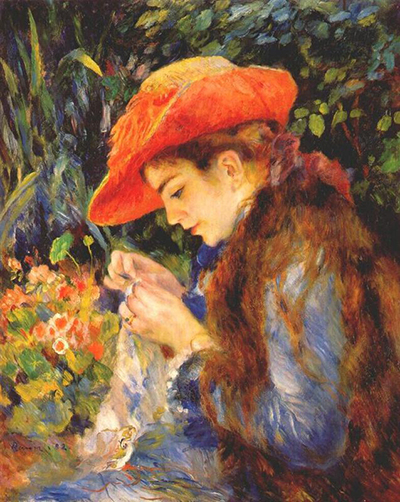Marie-Therese Durand-Ruel Sewing is an oil on canvas portrait painted by Pierre-Auguste Renoir in 1882
The portrait shows the subject of the painting sitting in a beautiful garden and she is looking down, fully concentrating on the sewing that she is holding.
The subject of the painting, Marie-Therese Durand-Ruel, was the daughter of the French art dealer Paul Durand Ruel and he commissioned Renoir to complete this portrait, along with portraits of his other children. The garden that is the setting for the portrait is believed to be the garden of their family home in Normandy, France.
Pierre–Auguste Renoir is well known for being a part of the impressionist movement, but this portrait was painted during a time when his style of painting was changing direction. During a trip to Italy in 1881 Renoir began to adopt techniques to define the subject of his portrait paintings against soft background.
These changes to his painting style came in reaction to Renoir seeing classical artwork by well-known artists such as Raphael. After the trip Renoir changed the style of his own artwork for the next several years, giving it a more classical and renaissance feel.
This change in style can be seen in this portrait by the way her figure is clearly defined against the garden that she is sitting in.
Renoir was also influenced during this time by the French neo-classical artist Jean Auguste Dominique Ingres.
As mentioned earlier, the portrait shows Marie-Therese Durand-Ruel sitting in the garden of her family’s Normandy home.
The garden is painted in a typical Renoir style, with soft brushstrokes and colours, making an almost dreamlike background. There is a sense of serenity and beauty with a feel of soft dappled sunlight peaking through the leaves on a perfect summers day.
The portrait of Marie-Therese is much more clearly defined with sharper lines and stronger, bolder lines. This really makes her the focus of the painting and the eye cannot help but be drawn to look at her.
The artist also painted Camille Monet on several occasions, though there was not one specific woman that he would portray endlessly, which has been the case with some other artists. Dora Maar and Jacqueline, for example, featured consistently throughout periods of Pablo Picasso's career. Gustav Klimt would also Adele Bloch-Bauer frequently as a model.
The concentration the subject is bestowing on her needlework is clearly evident, but we can’t quite see exactly what she is sewing. This only adds to the appeal of the painting.
The colours used to paint her are also stronger and bolder, especially the colours used to paint her outfit and hat, as well as her hair. The garden consists of darker hues at the back and then lighter, softer colours towards the front and these are greatly contrasted by the rich red and orange tones of her hat and the rich brown tones of her hair. Marie-Therese’s dress is painted with the same soft techniques as the garden, with rich blue tones and this really encourages the eye to be drawn to her face.
This is a captivating painting that captures the continually developing style of Pierre- Auguste Renoir.




